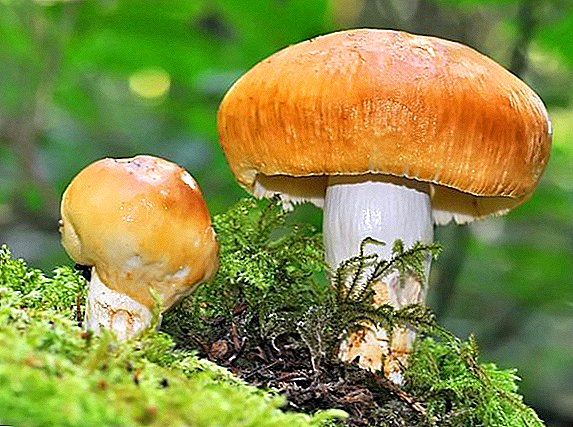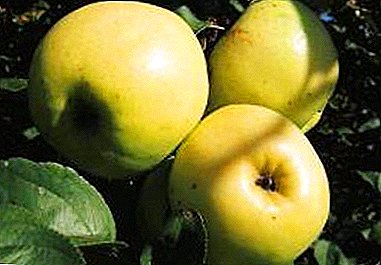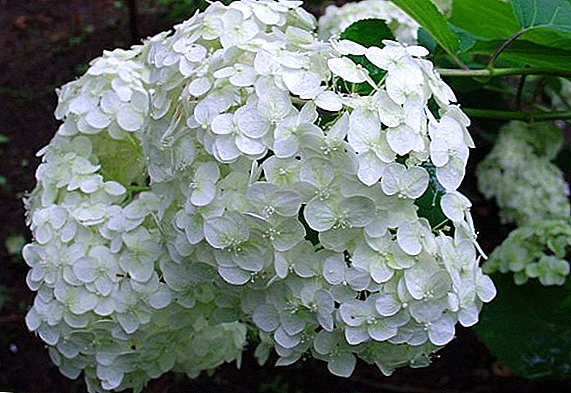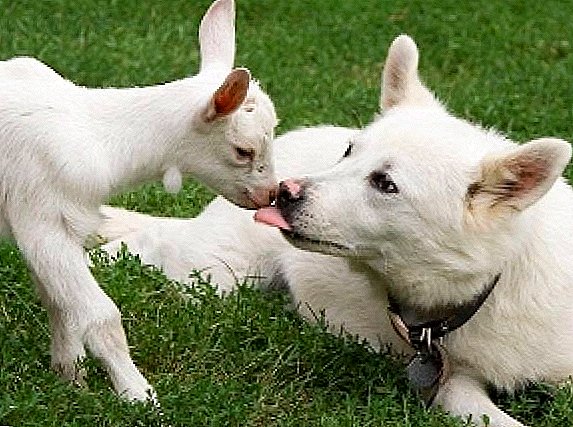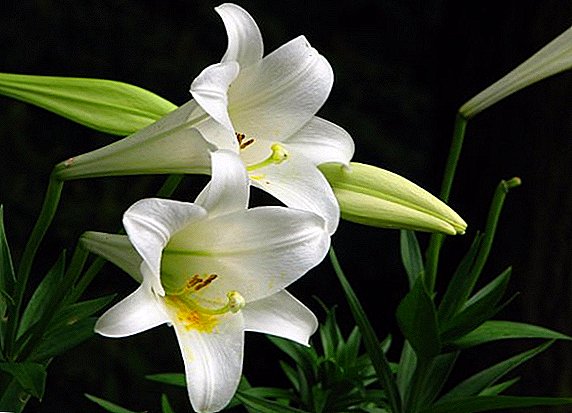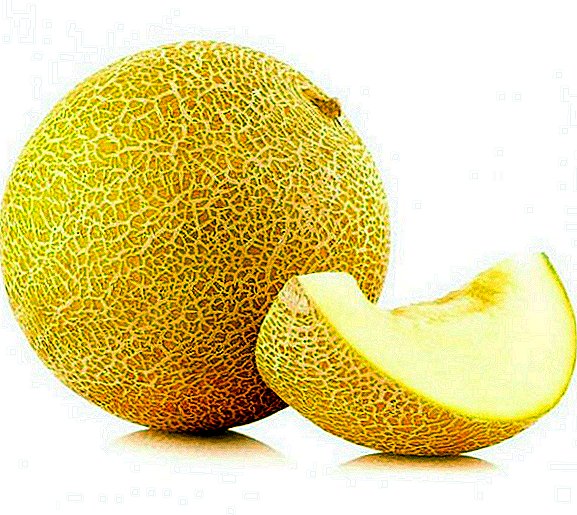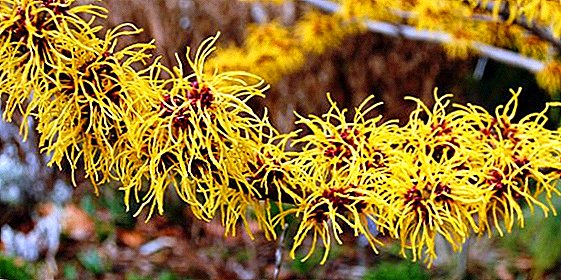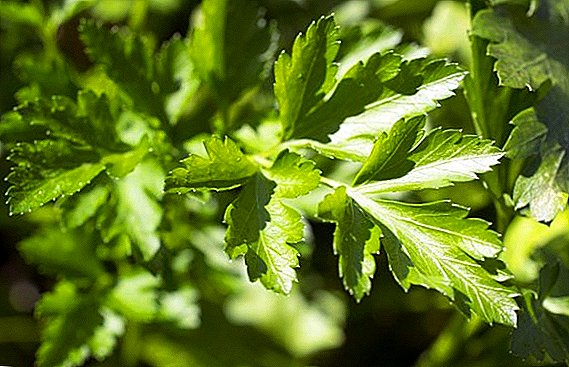 Parsley is the most common spice in our country. In cooking, use both the leaf and the root of this plant. Culture is grown on almost every household plot. In this article we look at the causes of poor parsley growth and ways to fix it.
Parsley is the most common spice in our country. In cooking, use both the leaf and the root of this plant. Culture is grown on almost every household plot. In this article we look at the causes of poor parsley growth and ways to fix it.
Why parsley does not grow: the main reasons
Parsley is one of the most frequently grown vegetables in our gardens. Its underground part is a white root with dense pulp and a sheet rosette, which has a characteristic, intense aroma. Parsley is often added to food as it is useful: its use has a positive effect on the human body, helps to get rid of toxins, removes excess water from the body.
The plant is a good source of potassium, calcium, magnesium and iron, which have a positive effect on blood circulation and fight anemia. The herb contains a large amount of vitamin C. To satisfy the body's daily need for this vitamin, it is enough to eat a tablespoon of chopped parsley leaves. In addition, the vegetable is rich in vitamins A, K, PP and vitamins of group B.  The nutritional value of parsley Especially high in it is vitamin A, which has a positive effect on human vision. In addition, parsley has antiseptic properties, has a positive effect on the digestive process, prevents urinary tract infections, while being a rich source of fiber.
The nutritional value of parsley Especially high in it is vitamin A, which has a positive effect on human vision. In addition, parsley has antiseptic properties, has a positive effect on the digestive process, prevents urinary tract infections, while being a rich source of fiber.
Besides the health benefits, parsley is simply delicious. The root crop and greens of this vegetable are usually used in the kitchen as a supplement to the first dishes, giving them a wonderful aroma, as well as to meat, fish and salads. The plant is used as a spice, which has an intense aroma and gives the dishes a unique smell and taste.
Did you know? In ancient Greece, parsley was used to make funeral ornaments. In addition, lush and bright stems were used for weaving wreaths of glory to the winners of sports competitions.
Growing parsley is not a very simple task; sometimes, by applying diligence and perseverance, the gardener does not get the proper return - the plant simply refuses to grow or grow frail and pale. This suggests that the culture does not receive the right care. Perhaps it lacks watering, feeding, it is poorly lit or grows in unsuitable composition of the soil.
Lack of irrigation and fertilizer
Like any other crop, this plant has certain growing requirements. Having average nutritional requirements, the culture will not grow on empty, barren soils. It tolerates the lack of phosphorus in the soil and low nitrogen content, but in the soil where there is no potassium, it refuses to grow.  It is best to fertilize this crop with organic fertilizer, spreading it over the surface of the beds and when digging, mixing with the top layer of soil. Fertilizing the beds of fertilizer beds is carried out in the fall, using a shovel or garden pitchfork. Depending on the needs, the fertilizer is used before sowing the seeds or feeding during the growing season.
It is best to fertilize this crop with organic fertilizer, spreading it over the surface of the beds and when digging, mixing with the top layer of soil. Fertilizing the beds of fertilizer beds is carried out in the fall, using a shovel or garden pitchfork. Depending on the needs, the fertilizer is used before sowing the seeds or feeding during the growing season.
When fertilizing beds you can use:
- compost;
- granulated or dried manure;
- green manure (fermented grass solution);
- vermicompost - a product of the life of the California earthworm;
- humus liquid dressings;
- mineral fertilizers.
Did you know? The high level of chlorophyll in the leaves allows you to use parsley as a mouth freshener. After a person reaps a small amount of the leaves of this culture, the breath acquires freshness.
Parsley is very sensitive to both deficiency and excess water in the soil. As a result of drought, plants germinate poorly and then grow poorly. However, it should be remembered that too wet, swampy soil is also not suitable for culture. Both deficiency and excess water cause branching of the roots, reduce the yield and increase the susceptibility of the crop to diseases, so you should remember about rational watering.  After sowing seeds, until sprouts appear on the soil surface, the soil must be maintained in a slightly damp state. To do this, spend the evening irrigation beds from a garden watering can or cover it with agrofibre, preventing evaporation of moisture from the soil. The second option is preferable because it contributes to water saving and less labor-intensive for the gardener.
After sowing seeds, until sprouts appear on the soil surface, the soil must be maintained in a slightly damp state. To do this, spend the evening irrigation beds from a garden watering can or cover it with agrofibre, preventing evaporation of moisture from the soil. The second option is preferable because it contributes to water saving and less labor-intensive for the gardener.
The humidity of the earth is maintained even after the appearance of young plants, up to the formation of a well-developed leaf rosette. After that, the frequency of irrigation is reduced to 1 time per week. Watering, use on each running meter of a bed not less than 10 l of water.
Inappropriate soil
It is best to grow a culture in a warm and sunny place. She likes light, permeable soils, but it grows well on sandy soils. Culture does not like wet, heavy soil with a tendency to the formation of soil crust. The plant grows weakly and on acidic soils. A suitable pH of the soil for the cultivation of parsley is 6.5-7.5. You can find out the acidity of the soil using an electronic meter.
If the readings of the device differ significantly from the norm, the procedure of soil deoxidation or acidification should be applied accordingly. The soil is usually deoxidized by liming. For sowing parsley soil deacidation is recommended in the year preceding the cultivation of the crop.  It is important for crop growers to get both full-fledged roots and a well-developed leaf rosette; therefore, providing the spice with a suitable soil is necessary, because vegetation in the wrong soil can lead to multiple root splitting. This usually occurs when grown in too heavy clay (stony or acidic) lands with high groundwater levels.
It is important for crop growers to get both full-fledged roots and a well-developed leaf rosette; therefore, providing the spice with a suitable soil is necessary, because vegetation in the wrong soil can lead to multiple root splitting. This usually occurs when grown in too heavy clay (stony or acidic) lands with high groundwater levels.
On heavy soils, you can grow crops in high beds, which improves the conditions for growing parsley and limits the branching of its roots. The branching of the root can also be caused by the introduction of fresh manure into the soil in spring, as well as an excess or lack of water in the soil. In addition to suitable soil in the garden, for good growth of parsley, it is important to observe crop rotation.
Important! Parsley seeds pasted on paper tapes can be purchased at garden stores. For sowing, such seed tapes are simply laid out on a bed and sprinkled with soil.
It must be remembered that the culture belongs to the umbrella family, so do not sow it after other plants belonging to this family. Observing the crop rotation, the spice cannot be returned to the former bed more often than once in 4 years. Shorter breaks in crop rotation contribute to the appearance of diseases and pests that are dangerous to the crop. Parsley, as a root plant, should not be planted to obtain root crops after other root plants (carrots, beets, turnips).  Best of all, it succeeds after such predecessors as leafy plants. In order for the crop to please you, when growing a crop, you need to pay attention to the plants growing next to the garden bed. For parsley, the best neighbors are radish, tomatoes and onions, which protect parsley from carrot flies. To protect against root nematodes, it is best to plant marigolds next to parsley. Unfavorable neighborhood for her - leaf and cabbage lettuce.
Best of all, it succeeds after such predecessors as leafy plants. In order for the crop to please you, when growing a crop, you need to pay attention to the plants growing next to the garden bed. For parsley, the best neighbors are radish, tomatoes and onions, which protect parsley from carrot flies. To protect against root nematodes, it is best to plant marigolds next to parsley. Unfavorable neighborhood for her - leaf and cabbage lettuce.
Poor lighting and humidity
Home garden bed for green plants is often located in a place partially obscured during daylight hours. For parsley, this is absolutely unacceptable, it immediately reacts to a lack of light, slowing down in growth. In this case, the quality of the leaf rosette also deteriorates, the leaves become pale, almost yellow, lose their juiciness, and instead acquire stiffness and durability of the petioles.
Did you know? In 2001, a document came into force in the Russian Federation attributing curly parsley to plants with high content of narcotic, potent or toxic components.
For green crops, good lighting is one of the main requirements for growing conditions, so the bed with parsley must be located in a place well lit by the sun. At least, the sun's rays should illuminate the culture at least 5-6 hours a day.  Parsley loves water, but does not tolerate excessive moisture and on root-covered soils it quickly becomes sick with root rot. It is best to keep the soil under the crop constantly in a slightly damp state. Extremely dangerous for the culture is a combination of poor lighting and excessive watering, in which case the leaf rosette is quickly affected by one of the fungal diseases, such as powdery mildew.
Parsley loves water, but does not tolerate excessive moisture and on root-covered soils it quickly becomes sick with root rot. It is best to keep the soil under the crop constantly in a slightly damp state. Extremely dangerous for the culture is a combination of poor lighting and excessive watering, in which case the leaf rosette is quickly affected by one of the fungal diseases, such as powdery mildew.
How much time should grow
After the emergence of sprouts on the surface of the bed, which happens rather late and takes 3 to 4 weeks, the plant develops slowly for a couple more weeks. As soon as leafy rosettes consisting of 4-5 stems appear on the crop, development accelerates, and after a month and a half after sowing, the first crop of green leaves can be harvested.
You will be interested to know when to sow parsley in the spring.
After cutting, the plant quickly recovers leaf mass, for this it takes no more than 10 days. When harvesting greenery, it is advisable to remove all adult leaves at the very base of the outlet, since the old petioles that are not cut off slow down the buildup of new leaf mass and degrade the quality of the green cut.  Parsley will increase all new and new leaves during the whole warm season, until the onset of cold weather. Usually the growing season on the street takes from 5 to 6 months. You can extend the season of growing spices, covering the bed with plastic film or agrofibre. Many housewives also practice autumn transplant of parsley plants from the garden into pots in order to continue growing in the house.
Parsley will increase all new and new leaves during the whole warm season, until the onset of cold weather. Usually the growing season on the street takes from 5 to 6 months. You can extend the season of growing spices, covering the bed with plastic film or agrofibre. Many housewives also practice autumn transplant of parsley plants from the garden into pots in order to continue growing in the house.
How can you refresh the greens and accelerate its growth at home
Spicy greens (parsley, dill, basil) are often grown in homes on windowsills or balconies. The situation is quite common when parsley grows poorly in pots, its rosette is not thick, the leaf petioles are too elongated, and the color of the stems is pale-green. Most likely, the growing conditions are not met: the composition of the soil is not suitable, poor lighting in the house or on the balcony, the plant is too much or too little water.
Important! You can store frozen parsley (roots and leaves) in the freezer in sealed plastic bags. Both frozen and dried, fragrant seasoning retains most of its properties.
For plants growing in containers, inappropriate conditions are quite easy to eliminate:
- With a lack of light, it is only necessary to rearrange the pot of parsley on the window-sill of the south window, and after a while the pallor of the leaves will disappear. If the apartment has all the windows facing north or west, next to the pot in which the green grows, it is advisable to install a lamp for highlighting. In winter, greens are lit in the morning and evening. The best hours for this are: morning from 8:00 to 10:00 and evening from 18:00 to 20:00.
- It does not provide complexity for the plant to eliminate the consequences of improper watering. If the soil in the pot is too flooded, it is not watered for 7-10 days until it dries well. For pot parsley, the frequency of watering should not exceed once a week, besides watering should be moderate. The signal for irrigation is dried up topsoil (to a depth of 1-2 cm).
- A problem with an unsuitable composition of soil in a pot is also easy to solve, it is advisable for this to buy a soil in the gardening shop with the right pH value and transplant spice to new land. When transplanting the pot, you can leave the old one, but before starting the procedure it is advisable to wash its inner walls well with a sponge with soap. It is necessary to put a layer of drainage on the bottom of the planting tank, this will help to avoid rotting of the roots. As a drainage, you can take fragments of ceramic dishes or pieces of foam. The drainage layer should not exceed 1/10 of the pot volume.
- Periodically, potted plants need root and leaf feeding. Such a need comes after rapid vegetation, greatly depleting the plant. To revive the depleted plant, apply fertilizer. For root dressings any organic matter is suitable after fermentation. Since the solution of organic fertilizer is obtained rather concentrated, in order not to burn the roots of the spice, 10 parts of water are taken for one part of the fertilizer. Top dressing by organic is carried out 2 times a month. The plant is fertilized at the root after it has been watered (on wet soil). For top dressing, you can also use ready-made fertilizer for green crops purchased in the garden center. As foliar fertilizing, you can sprinkle the leaves with a solution of biological growth stimulant, for example, with Emistim or Appin.

Useful tips gardeners
Experienced gardeners know that in the process of growing any crop has its own nuances. Catching parsley is no exception. How to sow parsley to get a good harvest:
- You can grow a culture on flat or high beds. The first method works better on sandy and permeable soils. When the soil is heavy, clayey, it is recommended to grow a crop on raised beds (ridges). However, it should be remembered that the soil in the ridges dries faster than on flat terrain, and in case of drought, these beds should be watered more often. In order to make even rows when sowing seeds, the grower can stretch the marker string (rope) and form ridges along it. Marker twine is also used when sowing seeds on flat surfaces to sow even rows.
- Sowing parsley begins at the turn of March and April. It is recommended to disinfect the seeds before sowing with a special preparation for the destruction of diseases and pests transmitted with the seed, then soak them in the preparation against infection or damage by soil pathogens. Parsley has a long period of germination (3-4 weeks) and a long growing season, so it should be sown as early as possible, especially since it is not sensitive to low temperatures. Parsley seeds begin to germinate at + 2 ... + 4 ° C, and saplings and wintering plants can withstand temperatures down to -9 ° C.
- Seeds are sown to a depth of about 2 cm, rows are placed every 20-30 cm. The distance between the plants in a row is regulated by tearing out the extra plants after the seedlings form two pairs of true leaves. After thinning crops between seedlings there will be a distance of 4-6 cm.
Important! When transplanting you need to ensure that the parsley rosette is not too deep into the ground, because in this case the plant will not be able to grow new leaves.
Parsley can be seen growing in almost every garden, and it is also popular as a green spice for container growing. If you provide the plant with all the necessary conditions for growth, during the growing season you can take up to 5 green cuts and grow excellent spicy roots.



